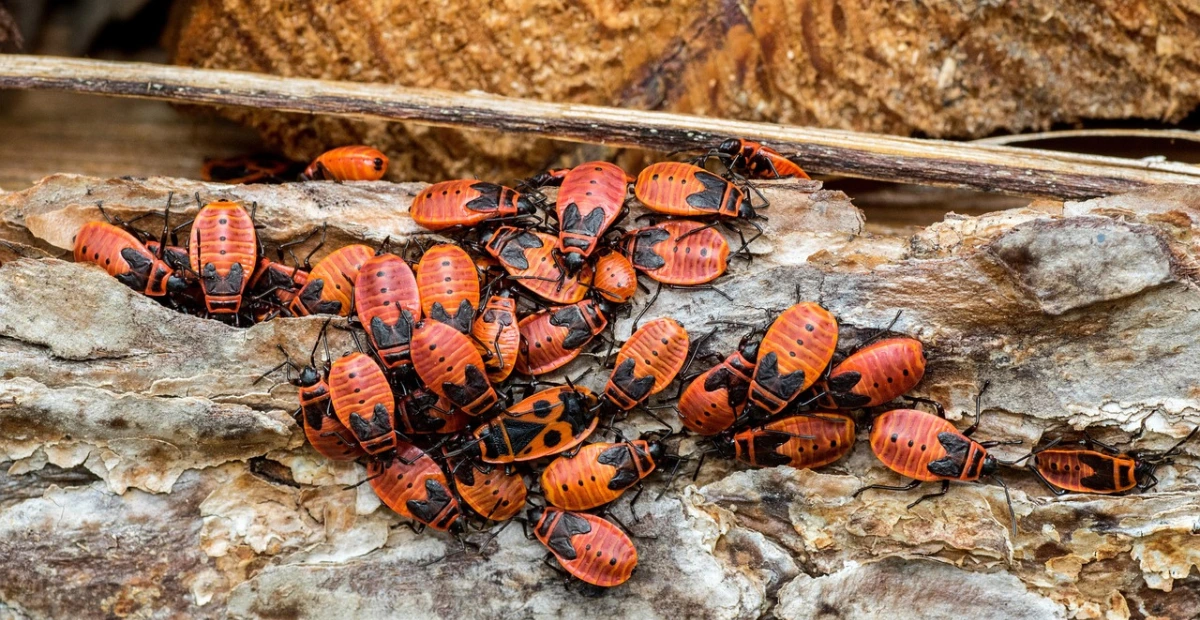If you’ve spent hours perfecting your garden, watching it bloom and thrive, the last thing you want is to see tiny red bugs outside, silently destroying all your hard work. You’ve carefully nurtured your plants, and suddenly, these tiny invaders start to sap their life force, leaving you frustrated and unsure of what to do. What’s worse, they seem to pop up out of nowhere, threatening your garden’s entire ecosystem.
advertisement
Don’t worry—you’re not alone. Tiny red bugs outside, like aphids, spider mites, and clover mites, can wreak havoc on your plants, but with a little knowledge and action, you can protect your garden. In this article, we’ll explore five highly effective ways to keep these tiny red bugs at bay and restore peace to your garden. Ready to learn how to defend your plants? Let’s dive in.
Table of Contents
What Are Tiny Red Bugs Outside?
Understanding Tiny Red Bugs
When you first spot tiny red bugs outside, it’s easy to assume they’re just another garden nuisance. But understanding exactly what you’re dealing with can make all the difference in how you approach the problem.
Tiny red bugs are typically classified into three main types: red aphids, spider mites, and clover mites. These insects may be small, but they pack a punch in terms of the damage they can do to your garden. They’re often found feeding on plant sap, which weakens the plant, causing yellowing leaves, stunted growth, and even plant death if left unchecked.
advertisement
Common Types of Tiny Red Bugs
- Red Aphids: These tiny, pear-shaped insects often appear in clusters. They can be found on the underside of leaves, feeding on the sap of your plants.
- Spider Mites: Spider mites are not true spiders but are related to them. They’re known for their ability to weave fine webbing over infested plants, which is often a telltale sign of their presence.
- Clover Mites: These are smaller than aphids and mites, but they often swarm in large numbers. While they don’t directly harm plants, they can cause unsightly damage to your garden and home.
Why Tiny Red Bugs Are a Problem
Tiny red bugs outside may seem insignificant, but they’re capable of causing major damage to your plants. They drain vital nutrients by sucking sap from stems, leaves, and flowers, weakening the plant and making it more susceptible to disease. In some cases, infestations can lead to stunted growth, discoloration, or even the death of your plants.
By dealing with these pests quickly and effectively, you can prevent them from spreading throughout your garden and causing long-term damage.
5 Ways to Keep Tiny Red Bugs Outside Out of Your Garden
Now that you understand the problem, let’s explore five proven ways you can use to keep tiny red bugs outside and safeguard your garden.
1. Use Natural Predators
One of the best ways to combat tiny red bugs outside is by introducing natural predators. These beneficial insects prey on pests like aphids, spider mites, and clover mites, reducing the need for harmful pesticides.
How to Attract Natural Predators
Several insects, including ladybugs, lacewing larvae, and predatory mites, are natural predators of the tiny red bugs you’re trying to control. You can attract them to your garden by planting a variety of flowers and herbs that act as natural attractants, such as dill, fennel, or cilantro. These plants provide food and shelter for the beneficial insects, encouraging them to take up residence in your garden.
advertisement
Benefits of Natural Predators:
- Non-toxic solution: No chemicals, just nature at work.
- Long-term pest control: Once you have a population of natural predators, they’ll help keep pests in check for a long time.
- Safe for the environment: This approach is eco-friendly and won’t harm other beneficial creatures in your garden.
By creating an environment where beneficial insects can thrive, you can maintain a natural, balanced ecosystem in your garden while effectively keeping tiny red bugs outside.
2. Implement Natural Repellents
If you’re looking for an effective, chemical-free solution, natural repellents are a great option. These eco-friendly solutions can repel tiny red bugs without causing harm to your plants, pets, or family.
Top Natural Repellents
- Neem oil: Known for its ability to disrupt the life cycle of pests, neem oil is a powerful yet safe option for repelling red bugs. It works by suffocating pests and preventing them from reproducing.
- Garlic spray: Garlic is a natural insect repellent. Mixing garlic with water creates a potent spray that deters pests from infesting your plants.
- Peppermint oil: The strong scent of peppermint is unpleasant for red bugs and works as a natural deterrent. It’s particularly useful in keeping aphids and mites at bay.
How to Make and Apply Your Own Repellent:
Making your own natural repellent is simple. Here’s a quick guide:
- Mix 2 tablespoons of neem oil with 1 liter of water.
- Add 1 teaspoon of dish soap to help the mixture adhere to plant surfaces.
- Shake well and spray directly onto affected areas of the plant.
Benefits:
advertisement
- Eco-friendly: No chemicals involved.
- Affordable: Save money by making your own repellent.
- Safe for your plants: It won’t harm your garden’s health, but it will discourage pests.
Natural repellents are an excellent way to protect your plants without relying on harmful chemicals. Plus, they’re easy to make and use!
3. Keep Your Garden Clean & Well-Maintained
A well-maintained garden is a happy garden—and one that’s much less likely to fall prey to tiny red bugs. Keeping your garden free from debris, dead leaves, and overgrown plants eliminates places where pests can hide and breed.
How to Keep Your Garden Tidy:
- Trim plants regularly: Regularly prune your plants to remove dead or infected branches. This not only improves the plant’s health but also removes potential hiding spots for pests.
- Remove dead plant material: Tiny red bugs love to nest in decaying plant matter, so make sure to clean up any fallen leaves or stems.
- Properly dispose of infected plants: If you find a plant infested with tiny red bugs outside, remove it immediately to prevent the pests from spreading.
Benefits:
- Prevents pest build-up: A clean garden discourages pests from settling in.
- Promotes healthy growth: Plants that are regularly maintained are more resilient to infestations.
- Easier to spot issues: A tidy garden makes it easier to spot tiny red bugs before they become a major problem.
advertisement
By keeping your garden clean and well-maintained, you can reduce the likelihood of tiny red bugs outside making themselves at home.
4. Use Physical Barriers
If you’re looking for immediate protection, physical barriers can be an excellent way to block tiny red bugs outside from reaching your plants. Row covers, mesh nets, and even simple garden cloches can shield your plants from pest invasions.
Types of Physical Barriers:
- Row covers: These lightweight fabric coverings allow sunlight and rain to reach your plants while keeping pests out.
- Mesh netting: Fine mesh netting can be draped over plants to create a physical barrier that pests can’t get through.
- Cloches: These small, dome-shaped covers are ideal for protecting individual plants, especially delicate seedlings.
Benefits:
- Immediate protection: A physical barrier offers instant defense against pests.
- Non-toxic: No chemicals needed—just physical protection.
- Versatile: Barriers can be moved around and adjusted depending on your garden’s needs.
Using physical barriers is a quick, efficient way to protect your plants from tiny red bugs while maintaining a chemical-free garden.
5. Regularly Water and Prune Your Plants
Healthy plants are less likely to succumb to pest infestations, so proper watering and pruning are essential to pest control. Not only do these practices promote plant health, but they can also make your plants less attractive to tiny red bugs outside.
advertisement
How Proper Watering Helps Prevent Pests:
- Hydration: Plants that are well-watered are healthier and more resistant to pests. However, avoid over-watering, as soggy conditions can attract pests like aphids and spider mites.
- Drainage: Ensure your garden beds have proper drainage to avoid standing water, which attracts pests.
The Importance of Pruning:
- Pruning removes dead or damaged plant parts that may harbor pests.
- By cutting away weak growth, you allow your plants to focus their energy on healthy, thriving parts.
Benefits:
- Healthier plants: Well-watered and properly pruned plants are more resistant to pests.
- Reduced risk of infestation: Healthy plants are less appealing to tiny red bugs outside.
A little bit of regular care goes a long way in keeping pests out and ensuring your garden remains vibrant.
Conclusion
Dealing with tiny red bugs outside doesn’t have to be a constant battle. By using natural predators, implementing natural repellents, keeping your garden clean, using physical barriers, and properly caring for your plants, you can prevent these pests from taking over your garden. Remember, a proactive approach is key to maintaining a healthy, pest-free garden.
Don’t let tiny red bugs outside get the best of your hard work. Start implementing these strategies today and watch your garden thrive! Want more tips on pest management? Subscribe to our newsletter for the latest gardening advice!
advertisement
FAQ – Tiny Red Bugs Outside
Q: What are the most common types of tiny red bugs outside?
A: Tiny red bugs commonly found in gardens include red aphids, spider mites, and clover mites. Each of these pests feeds on plant sap, causing damage to your plants.
Q: How do I know if my plants are infested with tiny red bugs?
A: Look for signs such as yellowing leaves, distorted growth, or visible tiny red bugs on the plant. A fine webbing may also indicate a spider mite infestation.
Q: Can tiny red bugs outside cause long-term damage to my garden?
A: Yes, if left untreated, tiny red bugs can cause significant damage by weakening your plants and spreading disease. Early intervention is crucial to prevent long-term damage.
Q: Are there chemical treatments I can use for tiny red bugs outside?
advertisement
A: While natural remedies are preferred, chemical treatments are available. However, they should be used with caution to avoid harming beneficial insects in your garden.


